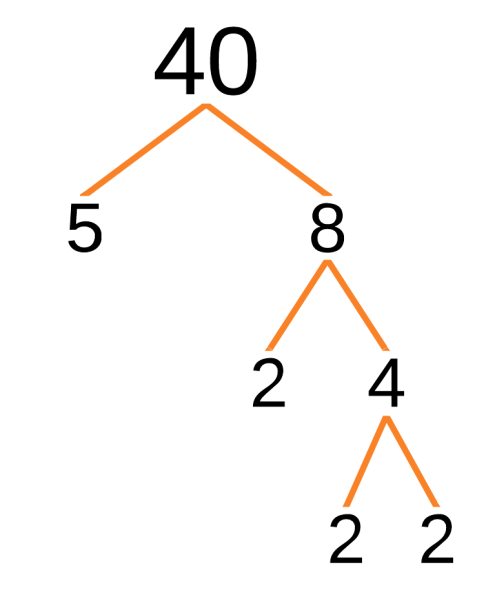Introduction
In this lesson, you will learn the basic structure of prime factorization. A prime number can only be divided by one and itself.
These videos illustrate the lesson material below. Watching the videos is optional.
Identifying Prime Numbers
Learning how to find the prime factorization of a number is important when you start learning about fractions. It is especially important when reducing fractions. Here are some vocabulary words that will help you with this lesson:
- Factor: The numbers in a multiplication operation. (For example: In \(3\times4=12\), 3 and 4 are the factors of 12.)
- Product: The solution to multiplication. (For example: In \(3\times4=12\), 12 is the product.)
- Prime Number: Any number where the only factors are 1 and itself (for example: 11 is a prime number. There is no other number other than 1 and 11 you can divide it by that will give you a whole number).

Figure 1
Using the multiplication chart above, consider the following numbers and learn how to determine whether a number is prime:
- One is not considered prime; it is just the number one. There are reasons for that which aren't necessary to learn now. Just know that number one is not considered prime.
- Two is \(1\times2\) and it’s also \(2\times1\), but those are the only instances where you see the number two on the multiplication chart. So, two is only the product of one and itself, which makes it a prime number.
- Note: Number two is the only even number that is prime; all others are odd numbers. However, not every odd number is prime.
- Four is the multiple of \(1\times4\), \(4\times1\), and \(2\times2\). Four can’t be a prime number because it has other factors—1, 2, 4. Remember, factors are numbers that, when multiplied together, create a product.
- Seven is the product of \(1\times7\) and \(7\times1\). But again, those are the only two cases where three appears on the chart, which indicates that three is prime.
What are some other prime numbers on the chart? Figure 2 highlights the prime numbers in yellow up to number 139.

Figure 2
Prime Factorization
The smallest numbers you can break a number down into are prime numbers because a prime number cannot be broken down any further.
Example 1
14 isn’t prime because it is the same as \(2\times7\).

Figure 3
The factorization is \(2\times7\). To factor a number, break it down by listing the factors underneath, creating a tree-like shape. Then evaluate the factors. Because the factors 2 and 7 are both prime, this is as far as you can factor 14. Therefore, 2 and 7 are the prime factors of 14.
Example 2
There are lots of ways you can get 40, such as \(8\times5=40\) and \(4\times10=40\). This means that 40 can be factored multiple ways. First, try using the factors 4 and 10.

Figure 4
4 is not prime, so you can break it down even further. \(2\times2=4\), and 2 is prime, so that’s as far as you can go with the 4. The other factor, 10, is not prime either. 10 can be broken down into \(2\times5=10\), and 2 and 5 are both prime.
The prime factorization of 40 is \(2\times2\times2\times5\), or you could even put this in exponential notation as \(2^{3}\times5\). Both of these formats convey the correct answer.
Now try using the factors of 8 and 5 because 40 can also be broken down into \(8\times5\). The figure below shows this factorization.

Figure 5
Factoring it this way still got \(2\times2\times2\times5\) as the prime factors of 40.
Example 3
What is the prime factorization of 19? Look through the chart and see what multiples make up 19 before looking at Figure 6 below.

Figure 6
Because 19 doesn’t have any multiples other than 1 and 19, that is where factorization stops. 19 is a prime number.
Example 4
210 has a factor of 2 because it is an even number. \(2\times105\). 105 has a prime factor of 5 because it ends with 5: \(5\times21\). 21 has two prime factors of 3 and 7. So the prime factorization of 210 is \(2\times5\times3\times7\).

Figure 7
Once you know what prime numbers are, you learn that each number is made up of smaller prime numbers. Breaking a number down into the prime numbers that make it is called prime factorization. Every number has a prime factorization. For prime numbers, their only factors are themselves and 1.
Things to Remember
- Prime numbers are numbers that can only be divided by one and itself.
- Prime numbers are made up of odd numbers, except the number two. But remember that not every odd number is prime.
- Factors are numbers that create a product.
- Factoring out the number means you go all the way to the prime numbers. This can be done with any number you are given, even a prime number, although you won’t get very far.
Practice Problems
Find the prime factorization of the following numbers:- 21 (
- 13 (
- 30 (
- 12 (
- 54 (
- 250 (
Need More Help?
- Study other Math Lessons in the Resource Center.
- Visit the Online Tutoring Resources in the Resource Center.
- Contact your Instructor.
- If you still need help, Schedule a Tutor.